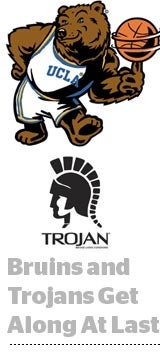National advertisers don’t particularly covet college media inventory. The buying process is manual and clunky, and the ad is often just an image slapped onto a rudimentary webpage. And don’t even think about any meaningful ad verification.
On the other hand, college media reaches a demographic that is very much coveted: affluent 18- to 24-year-olds – or at least 18- to 24-year-olds with affluent parents who bestow lavish allowances. It’s also a demographic which, in theory, will become affluent adults if they ever pay down their higher-education debt.
Even big universities like UCLA, which has its flagship newspaper, the Daily Bruin, plus UCLA Radio and seven community-oriented news magazines, mostly works with local advertisers.
But through an ad platform called flytedesk, it’s snagging national advertisers like Trojan condoms and the Adult Swim TV show “Dream Corp LLC.”
“We don’t have the manpower to reach out. All of our ad reps are students and are focused day to day on getting local clients,” said Doria Deen, UCLA’s student media director.
“College media is an underdeveloped market,” she added. “I think it’s overlooked.”
UCLA is one of flytedesk’s biggest clients. The tech platform is in 2,300 universities across the US and its goal is to pool college inventory – digital, print, out-of-home, radio and more – to make it available to national brand advertisers.
Consolidating that inventory means building tech with a lot of capabilities. There’s a planning tool to buy based on the demographics across different campuses and surface available media for purchase. There’s also a demand-side platform for digital ad placement that handles the uploading of creative, payment process and verification.
“Even if it’s a print ad in 500 campuses, you’ll see 500 images, which is how you verify media,” said flytedesk founder Alex Kronman. “That didn’t exist before. Advertisers can trust that something happens. They know exactly what it looks like in 48 hours.”
Kronman realized how much college media advertising could be improved when he was editor-in-chief of his university newspaper, The Catalyst, at Colorado College.
“The systems and processes hadn’t changed since the 1950s,” he said. “It never made sense to me that the media we were creating wasn’t accessible to the folks that most wanted to reach and engage us.”
Kronman estimates there’s $7 billion of existing media inventory across all US campuses.
AdExchanger Daily
Get our editors’ roundup delivered to your inbox every weekday.
Daily Roundup
“The largest subset of that is still in print media on campuses,” Kronman said. “It is probably the last place where print makes an enormous amount of sense.”
UCLA’s Daily Bruin publishes 7,000 copies each day Monday through Thursday, and 5,000 on Friday, with a pickup rate of 80%, Deen said. Online, it has 308,000 page views per month, though those figures are complicated because most UCLA students block online ads.
Advertisers can use flytedesk to buy inventory on the Daily Bruin and the outdoor kiosks that house the newspaper. The other seven magazines aren’t hooked up yet, Deen said, because they only recently started printing again thanks to a budget infusion.
But it’s out-of-home that represents one of the more interesting opportunities for flytedesk.
“The biggest thing we’re working on now is helping scale out-of-home inventory,” Kronman said. “We’re currently manufacturing more OOH units to give away to college media organizations to help them expand what they have to offer.”
Flytedesk has caught the attention of influential individuals in the digital ad ecosystem, having raised $5 million from ad tech honchos that include the founders of SpotX and Eric Roza, head of Oracle Data Cloud and Colorado’s biggest CrossFit fanatic.














